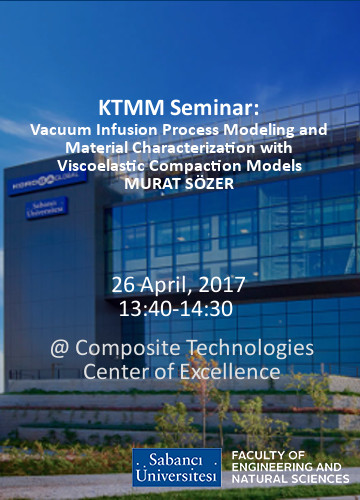KTMM Seminar:Vacuum Infusion Process Modeling&Material Characterization
Merhabalar,
26 Nisan Çarşamba, 13:40-14:30 saatleri arasında Teknopark Kompozit Araştırma Merkezinde, Assoc.Prof.E.Murat Sözer "Vacuum Infusion Process Modeling and Material Characterization with Viscoelastic Compaction Models" başlıklı seminer verecektir.
Sabancı Üniversitesi -Teknopark Gidiş
Araç Hareket Saati : 13:00Araç Hareket Alanı : Sunum Binası Önü
Teknopark- Sabancı Üniversitesi
Araç Hareket Saati : 14:45
Araç Hareket Alanı : KTMM Binası Önü

Title: Vacuum Infusion Process Modeling and Material Characterization with Viscoelastic Compaction Models
Speaker: E. Murat Sözer, Assoc. Prof., Mechanical Engineering, Koç University
Time: April 26, 2017, 13:40-14:30
Place: Teknopark- KTMM
Abstract:
The talk will start with a brief introduction of research topics conducted at the Composite Materials Manufacturing Lab in Koç University. I will talk about issues related with the following: two manufacturing processes (resin transfer molding and Vacuum Infusion); use of sensor systems to monitor mold filling and resin cure; and material characterization (fiber preforms’ permeability to resin flow and compaction under pressure).
The second part of the talk will be related to viscoelastic compaction modeling of fiber reinforcements used in composites manufacturing. Viscoelastic models have advantage over elastic models since they have the ability to model the time dependent compaction of the fabric. The compaction characterization of fabric preforms are done using five different viscoelastic models.
The results of this study contributes to the composite manufacturing literature with the following achievements: (1) a compaction characterization procedure is designed to mimic the compaction behavior of fiber reinforcements used in VI; (2) an automated characterization experimental setup is constructed to reduce human error and increase the repeatability; (3) experimental characterization data allows to have a database for two fabric types (random and woven); (4) five viscoelastic compaction models (Maxwell, Kelvin-Voigt, Zener, General Maxwell and Burgers) and an elastic compaction model are used to investigate different stages of VI; (5) comparison of the models allows to study the contribution of different elements of the compaction models and thus understand their physical responses in different stages. By coupling a resin flow model and a viscoelastic compaction model (preferably Generalized Maxwell with n=2 or Burgers depending on which stage(s) of VI is desired to be modeled) in a complete VI process model, it is possible to simulate more accurate gradual pressure and thickness changes with time during the application of control actions in VI post-filling stage. Elastic models fail in these situations because they cannot model time dependent response, and thus viscoelastic models of this study should be preferred.
Biograph:
Associate Professor, Koç University, College of Engineering, Mechanical Engineering Dept., Istanbul, Turkey
Director, Koç University Office of Learning and Teaching (KOLT), Istanbul, Turkey
He received B.S. and M.S. degrees in Mechanical Engineering at METU in 1986 and 1989, respectively; and Ph.D. in Mechanical Engineering at University of Delaware in 1995.
His research areas include modeling and control of composite materials manufacturing processes such as resin transfer molding and vacuum assisted resin infusion; material characterization experiments (permeability and compaction); fluid mechanics; and porous media flows. Professor Sozer has published more than 40 articles in the leading journals and conference proceedings, and co-authored one book and three chapters on process modeling in composites manufacturing.
He is the director of Koç University Office of Learning and Teaching (KOLT) since September 2012. KOLT has the following services to students, teaching assistants and faculty: peer-supported tutoring service; basic academic skills seminars for new-coming students; conversation circles for fluency in speaking English, training workshops for teaching assistants; curriculum development; teaching workshops for faculty; mid-semester course evaluations; promoting active learning (such as team-based learning and flipped classroom) and blended learning through learning management systems (MOODLE and Blackboard); supporting faculty to prepare new MOOC (Coursera) courses.
He is the recipient of “Outstanding Teaching Award” (Koç University wide) given by the President of Koç University, Prof. Umran Inan in 2011-2012 academic year when it was organized for the first time in the university history.